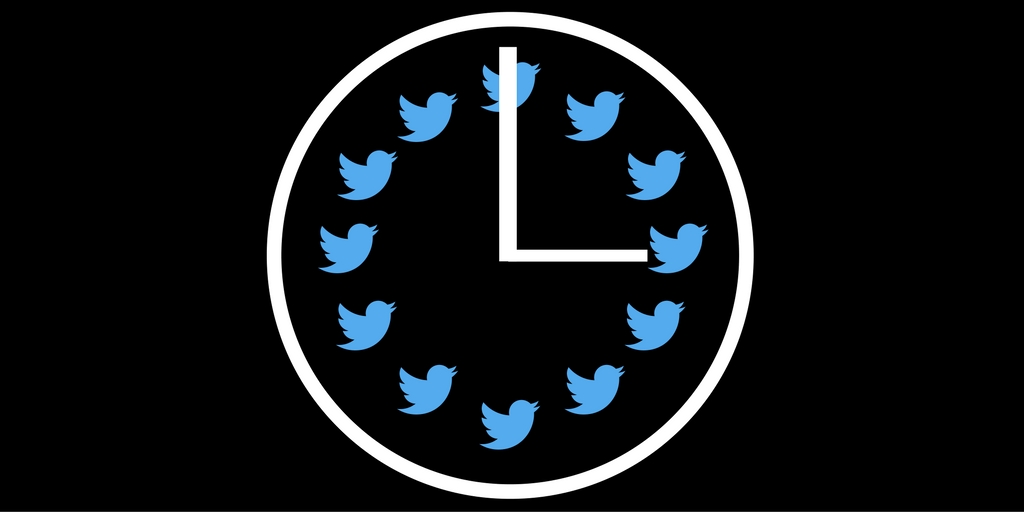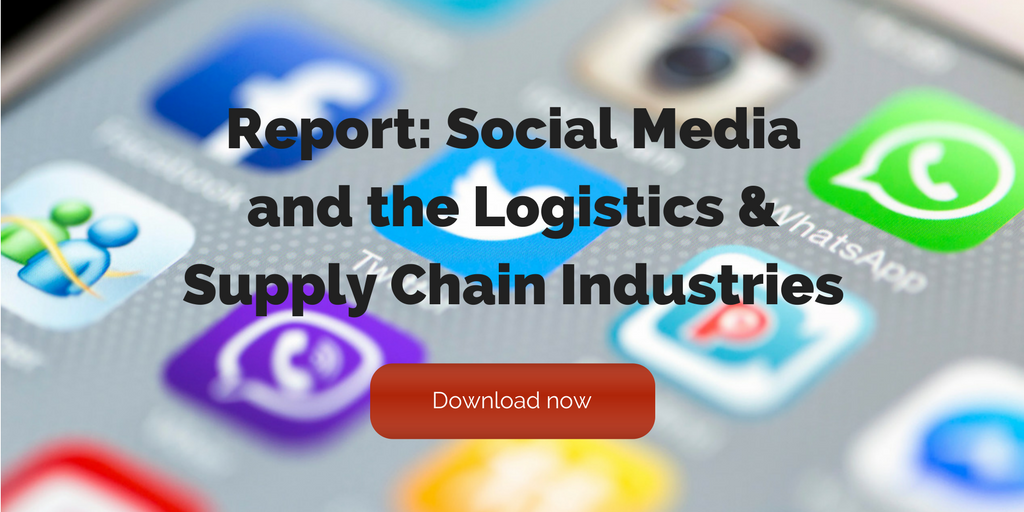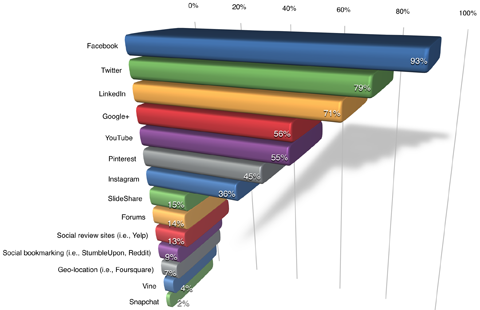
by Fronetics | Apr 11, 2016 | Blog, Content Marketing, Marketing, Social Media

What is the ideal frequency for posting to Twitter? We did the experiment.
 I came across an article on Socialbakers that suggested that posting to Twitter three times per day is the ideal frequency for brands. Intrigued by this statistic, I looked further and found that Buffer posts to Twitter 14 times per day.
I came across an article on Socialbakers that suggested that posting to Twitter three times per day is the ideal frequency for brands. Intrigued by this statistic, I looked further and found that Buffer posts to Twitter 14 times per day.
At Fronetics we typically post content to Twitter an average of 40 times per day. That’s an average of 40 times per day for Fronetics, and an average of 40 times per day for each of our clients. That’s a lot of time on Twitter. Given this, the numbers given by Socialbakers and Buffer caught my attention. Could we reduce the frequency to which we post to Twitter and keep (or even increase) engagement and ROI? We decided to do the experiment.
The results
As shown in our social experiment infographic, when we reduced the number of times we post to Twitter from 40 times per day to 15 times per day, our engagement and ROI plummeted.
Not only did we realize close to a 50% decline in traffic to the website, we also realized a 33% decline in new contacts. That’s a 33% decline in our lead pipeline.
We also realized a decline in link clicks (58%), profile visits (61%), retweets (65%), and new followers (39%). In short, our engagement numbers took a dive – off a cliff.
So, how often should you tweet?
Although the numbers were abysmal, the experiment was a good one. It showed that, for Fronetics, posting to Twitter at a frequency of around 40 times per day is right for our company.
Does that mean the frequency is right for each of our clients? No. Does it mean that the frequency is right for your business? No. What it means is that there is no magic number when it comes to the ideal frequency for posting to Twitter.
Your company, or your marketing partner, should conduct due diligence and determine what the right frequency is for your business. Yes, you may realize a significant decline in engagement in ROI during your experiment. On the other hand, you may realize an increase in engagement and ROI — captured with lower output in terms of time and resources.
Do the experiment. I’d love to hear your results, and learn what frequency works for your business.
Not tracking your metrics on a monthly basis? Start now. Metrics enable you to measure success, drive strategy, and demonstrate the ROI of your marketing efforts.
Related posts:


by Fronetics | Apr 6, 2016 | Blog, Content Marketing, Marketing, Social Media, Strategy

Fronetics Strategic Advisors helps clients increase brand awareness, foster meaningful customer engagement, and grow business.
Fronetics Strategic Advisors is a management consulting firm focused on identifying and executing areas for growth and value creation for our clients. We are unique in that we use a data-driven approach to align marketing programs with business objectives and to deliver results.
“Fronetics” is derived from the ancient Greek word fronesis, meaning wisdom or intelligence, and is translated as “practical wisdom.”
Our team of strategists, marketing professionals, writers, designers, and social media experts leverages industry experience to elevate our clients’ brand position within the industry. We work with you — getting to know your business, your target customers, your industry, and your competition — to create a digital and content strategy individualized for your specific situation and needs. We put metrics on all marketing activities and monitor them regularly. And then we identify challenges, trends, and opportunities and take action so that your content marketing program constantly evolves and delivers results.
Fronetics offers comprehensive digital and content marketing services, including: content creation, content curation, content distribution, social media management, email marketing, lead nurturing strategies, and pay-per-click. Learn more about what we can do for your business below.
Content Creation
There is a lot of content out there. If you want your content to stand out and drive profitable customer action, you need quality content. At Fronetics, we create quality content that drives results. Unlike other firms, we don’t outsource content creation. By keeping all content creation in-house we are able to ensure a quality product.
Our team creates the following types of content:
- Blog posts
- Articles
- eBooks
- Case studies
- White papers
- Newsletters
- Press releases
- Infographics
- Social media
- Custom content
Social Media
Social media is an incredible tool; however, for it to be effective it must be driven by strategy, be consistent, and must have someone managing the execution.
At Fronetics, our social media strategists distribute content, curate content, engage your target audience, and monitor your social networks. We develop a social media strategy that aligns with your company’s goals.
We analyze your competition, classify your target audience and cultural attributes, identify the influencers in your industry, recommend platforms, detail best-engagement practices, create social media schedules, and identify specific tactics that deliver results.
Through the proper execution of social media, your brand is given a voice and personality, and becomes more accessible to your target audience.
Strategy Workshops
To effectively attract target customers, generate leads, and establish your company and your brand within your industry, you need a digital and content marketing strategy; a piecemeal approach does not work.
At Fronetics we offer both half-day and full-day workshops to help your business create and execute digital and content marketing strategies that drive success and elevate your brand position within your industry. Our workshops are intensive and hands-on. By the end of the workshop you will have an actionable and sustainable strategy that is aligned with your company’s business objectives.
Following the workshop you will receive a full year of support from our expert staff.
Schedule a free marketing assessment
Related posts:

by Fronetics | Apr 5, 2016 | Blog, Content Marketing, Marketing, Strategy

The benefits of content marketing take more than a few months to come about.
Kate Lee, Senior Director of Strategy, recently wrote about a client who was disappointed in a newly adopted content marketing program and ready to quit — certainly they should be seeing more leads and more sales by now, right?! Since the company was just a few months in, the answer was no; that’s not how it works.
Content marketing is a long-term solution that helps businesses build brand awareness, grow their audience, and generate new leads and sales. But, like any good relationship, it takes time and effort to achieve results. You shouldn’t give up before the seeds you sow have time to bear fruit.
Just how long will it take for your content marketing strategy to yield results? Well, that really depends on your business and your goals, but you can count on at least six months. (Joe Pulizzi, founder of the Content Marketing Institute, says more like 18.) The point is, content marketing is not a magic, overnight solution. The reason reflects why content marketing is effective in the first place.
Let’s take a look:
Developing your strategy takes time.
Only 11% of companies without a documented content marketing strategy find their efforts to be successful, compared to 60% of companies with a strategy in place. (That number rises to 86% when the company designates someone to lead the strategy.) The significant increase in effectiveness can be attributed to the careful thought and research that goes into building a strategy.
You will need several months to build the foundation of your content marketing plan if it is to be effective. You need time to research the kind of content that resonates most with your audience and to truly understand the (very specific) demographic that finds value in what your company offers. Then you need time to determine and test which distribution channels will most effectively reach your target audience, to discern a plan for content production, and to build out an editorial calendar reflective of your strategy.
Without getting all of these pieces precisely right, you’ll waste an enormous amount of energy and resources working on an ineffective strategy. Take the time to evaluate the market for your business and its content marketing strategy, and you’ll realize results in time.
Becoming an authority takes time.
The goal of your content marketing efforts should be to be a consistent source of information and value to your audience, who gradually will come to trust your authority and reward you with their business when they are ready to make a purchase. And establishing yourself as an expert doesn’t happen overnight.
Consistency is key for two reasons. For one, the average B2B buyer consumes between two to five pieces of content before making a purchase decision. If your content is old, arbitrary, contradictory, or otherwise unreliable, buyers will chose a different vendor whose content is more trustworthy. Consistent and consistently good content keeps your target audience engaged and builds your credibility with them.
Secondly, search engines rank websites based on several factors, and one of the most important is consistency. If your company blogs every other month, compared to companies that post several days a week, your posts will be penalized in search results. And since very few readers click beyond the top five search results, you’re drastically reducing your organic search potential.
As a SumAll article put it, “Whether getting traffic to your blog or your content ranked in the search engines, it doesn’t happen overnight, but instead by repeatedly creating and distributing quality content on a frequent basis for the long-term.”
Building your audience takes time.
The B2B buying process is becoming longer and more complex because the majority of buyers (82%) are using more sources to research and evaluate products and services, and they are spending more time in the research phase itself. In fact, 71% of B2B researchers start with a generic search — rather than searching for a particular company — and do an average of 12 searches before even engaging with a specific brand’s site. They are 57% of the way down the sales path by this point, meaning they have already spent a fair amount of time educating themselves with the enormous amount of information available to them on the Internet.
This means you need to allow your target audience time to find you and complete thorough research about you and your competitors before you even realize that the lead exists. And likely there will be more time before a sale takes place.
Content marketing is much more about lead nurturing than producing instant results. As you build your reputation as a valuable source of information, you will simultaneously build a loyal following of readers and content consumers who continue to return to you for knowledge and, ultimately, purchases. Relationship-building is not a streamlined process, but it does foster the ever-valuable repeat business that will have a greater impact on your bottom line than a one-and-done sale.
Your sales cycle takes time.
Unfortunately, content marketing cannot decrease the length of your sales cycle. Thus, you can’t expect to see the fruits of your labors (in terms of dollars) until at least one cycle is complete.
There should be, however, hints along the way that your efforts are working. Metrics like increased website traffic, email registrations, and social reach offer clues that more potential customers are finding your business in their research. You should take these signs and continually evolve your strategy to accommodate what is working for your business.
Also keep in mind that while content marketing can have an enormous impact on generating and nurturing leads, it does not deliver sales on a silver platter. Sales teams still play a major role in building on those relationships and closing deals.
Give your relationship with content marketing time to play out, and don’t be afraid to adjust your strategy along the way if you find some things are working better than others.
Related posts:

by Fronetics | Mar 31, 2016 | Blog, Content Marketing, Marketing, Social Media, Supply Chain

Employ a content and social marketing strategy to nurture leads you meet during MODEX.
Hundreds of potential customers will be heading to Atlanta next week for MODEX, and you’re gearing up to gain lots of new business. That is, you and over 800 other exhibitors are hoping to gain lots of new business. So how do you plan to stand out among the competition?
Using content and social marketing to nurture leads surrounding the event will help maximize the benefits of attendance. You can bring more attention to your presence, which will help you find more new potential customers, and then you can increase your chances of converting them if you use these tools properly.
Here are some tips for before, during, and after MODEX for using content and social media to gain new business.
Before the show
1) Define your goals.
A trade show represents an opportunity to spread brand awareness, find new leads, and, of course, make sales. Decide what is most important to your business, and strategize around those goals. For example, if one of your goals is to increase your social following, make sure every handout, landing page, and face-to-face interaction includes a request to like you on Facebook (or elsewhere).
2) Promote your attendance.
With the trade show hashtag (#MODEX2016), use Facebook, Twitter, and LinkedIn to let your followers know that you will be attending and when and where they can find you. Engage with other attendees who are using the event hashtag. Offer teasers — such as photos of the freebies you’re bringing — to entice visitors, and provide any longer-form information (e.g., an excerpt from a presentation you’ll be giving) in a blog post, distributing it through your social channels.
3) Set up a landing page/landing pages.
Create an event-specific landing page that includes a call to action (CTA), like reserving a time to speak with you at the conference or downloading a coupon to redeem a free sample. Make sure to ask for some information (such as a name, company, or contact information) in exchange. Monitor traffic and keep a running list of leads who visit and provide their information.
4) Research the attendees.
Perform prospect research using the list of attendees, paying special attention to those who have provided their information on your landing page or connected with you on social media about the event. Check out their social pages to see what they’re saying about the event, and like or follow them. Connect with high-value prospects on LinkedIn and try to arrange a time to meet up during the show.
5) Prepare to nurture.
Draft content that you can distribute during and after the show. Examples include lead-nurturing email templates, slides from presentations you are giving, and other offers you plan to provide visitors. Create another landing page, which includes a special offer or specific information you’ll be providing during the show, to drive attendees to during and after the event.
During the show
6) Keep chatting.
Reach out to the people you meet during the show on their social media handles. A nice-to-meet-you tweet and/or an invitation to connect on LinkedIn shows that you remember and appreciate the potential customer. Send the lead-nurturing emails you prepared in advance.
7) Monitor social media.
Continue using the show’s hashtag to monitor the conversations that are happening online, and see if anyone is talking about your company. Like or reply to anyone who does to show you’re listening.
8) Generate content.
Trade shows are a great place to generate content. Post photos of your booth and attendees from your company, and create videos of product demonstrations, presentations, or customer testimonials. Share your thoughts on the issues being discussed, and keep track of those themes, as well as any recurring questions that attendees ask, for future content.
After the show
9) Plan out your editorial calendar.
Develop posts for your company’s blog over the coming months around the questions and issues that were raised during the show.
10) Keep up the conversations.
Continue to engage the people you met on Facebook, Twitter, and LinkedIn. Follow and like their pages, and invite them to connect.
11) Offer your leads something of value.
Make event presentation or speaking materials part of your lead nurturing activities by sharing them with prospects using Slideshare or email. Remind leads with whom you shared your special-offer landing page to visit. Make sure to segment your contacts based on their interests and send them only relevant offers.
How do you nurture leads around trade shows? Will you be attending MODEX this year?
Related posts:

by Fronetics | Mar 30, 2016 | Blog, Marketing

Use these six metrics to communicate the success of your marketing efforts to your boss.
If you are responsible for marketing for your company, you may feel that your tireless efforts are sometimes difficult to quantify to your boss. Much of what we in marketing do is behind the scenes, measured by myriad metrics that demonstrate our strategies are at work. Oftentimes, those metrics do not necessarily speak the same language as our boss.
We are motivated by website visits, conversion rates, generated leads per channel, engagement on social media platforms, blog post shares, email click-through rates, and many other methods that can illustrate the success of today’s marketing campaign. But when you are trying to present the impact of your marketing strategies to your boss, it is hard to demonstrate all of this with measurable results.
You probably sense this, too — a sort of unspoken question mark hanging in the thought bubble over your boss’ head. You share that email click-through rates went up 40%, and there is a blank expression on his or her face. You suspect your boss may not fully appreciate the importance or the overall impact of your work.
And you are probably correct. Bosses theoretically understand that a solid marketing team can directly impact your company’s bottom line, but a whopping 73% of executives don’t believe that marketers are focused enough on results to truly drive incremental customer demand.
Your boss is looking for marketing metrics that matter to him or her, ones that they clearly see a result (or a connection) in customer acquisition or increased sales. This means you must be prepared to report on data that deals with the total cost of marketing, salaries, overhead, revenue, and actual new customer acquisitions.
Six Marketing Metrics Your Boss Wants To Know
There are basically six marketing metrics that your boss is interested in. Here is a brief overview:
- Customer Acquisition Cost (CAC): This is a metric used to determine the average amount your company spends acquiring a new customer. Take what your company spends in marketing costs, divided by the number of new customers it produced. There you have the price of each new customer.
- Marketing Percentage of CAC: This is taking your marketing department costs and dividing it by the total cost of both sales and marketing to determine how much your company is spending on marketing as it relates to the what you spend to acquire new customers. A low marketing percentage of CAC shows that your marketing programs are relatively inexpensive for the results they are producing.
- Ratio of Customer Lifetime Value to CAC: This is an estimate of total value that your company derives from each customer, compared with what you spend to acquire that new customer.
- The Time to Payback CAC: This calculation demonstrates how many months it takes for your company to earn back the CAC it spent acquiring your new customers.
- Marketing-Originated Customer Percentage: This takes all of the new customers from a set time period and examines what percentage of them started with a lead generated by your marketing team.
- The Marketing-Influenced Customer Percentage: This is a metric that highlights all of the new customers that marketing interacted with while they were leads, anytime during the sales process.
When reporting to your boss about the most recent marketing results, it’s crucial to convey your performance in a way in which he or she can quantify the results in terms of impact to the company. Rather than focusing on “soft” metrics like per-post Facebook engagement, use the top six metrics that demonstrate how the marketing efforts led to new customers and what those customers are worth to the company’s growth and success.
For more tips on how to calculate and demonstrate theses metrics, download our cheat sheet on how to show your boss the measurable value of your marketing strategies.
Related posts:

by Fronetics | Mar 28, 2016 | Blog, Marketing, Social Media
 A recent collection of social media facts and stats offers an interesting look at B2B company and buyer behavior.
A recent collection of social media facts and stats offers an interesting look at B2B company and buyer behavior.
Last month, Webbiquity published a list of 49 social media facts and stats about user behavior on Facebook, Twitter, LinkedIn, Pinterest, Instagram, and Google+. These figures, collected from various studies, offer insight into how people and businesses are using social networking in recent times.
B2B companies may find several of the stats particularly interesting, and it may influence the way they think about social media marketing. I have pulled out some of the most applicable and offered some thoughts below.
Social media facts and stats from Webbiquity
88% of B2B companies use Facebook for marketing (and 96% of all B2C companies )
If you are not using Facebook in your marketing efforts, you are in a quickly growing minority. With 968 million active daily users, the largest social networking site offers a huge opportunity — actually, the most expansive opportunity available — for your business to attract, court, and convert potential customers. Here are some of our top tips for using Facebook to market your business.
93% of small business owners and marketers use Facebook.
Small businesses don’t have the time or budget to compete with large brands when it comes to marketing — but social media can level the playing field. Social media, and Facebook especially, is an ideal marketing platform for small businesses because it can be relatively inexpensive but have a high impact on growth. Your company can cultivate your brand, engage with customers, and form business relationships. Learn how two small companies saw enormous growth thanks to social media.
21% of consumers say they unfollow brands that post repetitive or boring content. 19% say they would unfollow a brand on Facebook if the brand posted too often — more than six times a day.
We know that creating good, original content is key to a successful inbound marketing strategy. But knowing how often to post to the various social channels can be one of the more intimidating obstacles to overcome. How do you know what’s too much and what’s too little? Learn how often you should post on social media.
74% B2B decision makers use LinkedIn to help make purchasing decisions.
Don’t let anyone convince you that social media channels are for personal use only: customers are online, and if you aren’t, you’re at a disadvantage. And since nearly three-quarters use LinkedIn for purchasing decisions, it’s critical that your business is strategic about your presence on the network. Check out this guide for creating the perfect LinkedIn company page to get started.
88% of B2B marketers in North America use Twitter for content distribution.
Twitter is one of the more effective channels for gaining business, and the numbers prove it. A Market Probe International survey found that 72% of those who follow a business on Twitter are more likely to make a purchase from that business, and that 82% of followers are more likely to recommend a product or service to friends and family. Additionally, 85% of respondents reported feeling a closer connection to a small business if they follow them on Twitter. Learn more about Twitter for business.
Pinterest has 47 million active monthly users worldwide, 80% of whom are women.
While Pinterest use is rapidly growing among B2C marketers, the B2B world still hasn’t quite figured it out yet. I pulled out the two above stats to show the enormous potential this channel has, particularly for businesses whose customer base is primarily women. Fronetics’ social prospecting workbook has some ideas on how to get started using Pinterest.
32% of U.S. companies with 100+ employees used Instagram for marketing activities in 2015. eMarketer predicts that number will jump to 70.7% by 2017.
The importance of Instagram for B2B companies will continue to grow. Here’s why: 90% of Instagram users are under age 35. A recent Google study showed an increasing number of Millennials on the B2B purchasing path — up to 46% of potential buyers were of this generation in 2014. Their preferences and behaviors are having a noticeable impact on B2B buyer behavior as a whole. So if your business wants to capitalize on the nearly 300 million active monthly users, Instagram should be on your radar.
64% of North American B2B marketers use Google+ to distribute content, but just 17% use it for new product launches (vs. 81% who use LinkedIn).
Americans may use Google+ less frequently than some of the other networks, but don’t count it out entirely. More people check the site than people realize, including die-hard fans of Google products and the many businesses who use the Google suite professionally.
Related links:


 I came across an article on Socialbakers that suggested that posting to Twitter three times per day is the ideal frequency for brands. Intrigued by this statistic, I looked further and found that Buffer posts to Twitter 14 times per day.
I came across an article on Socialbakers that suggested that posting to Twitter three times per day is the ideal frequency for brands. Intrigued by this statistic, I looked further and found that Buffer posts to Twitter 14 times per day.









